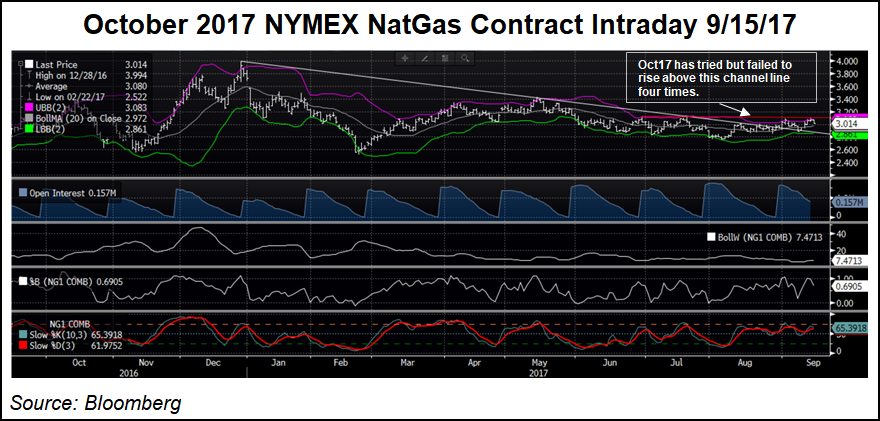NatGas Cash, Futures Both Give Up A Few Pennies Ahead Of Weekend
Physical natural gas traders Friday just couldn’t see getting stuck with a three-day commitment in a well-supplied market, and prices fell across a broad front. Gains in Appalachia couldn’t offset double digit losses in the Northeast, Midcontinent, Midwest, Rockies and California, and the NGI National Spot Gas Average skidded 9 cents to $2.58.

Futures bulls failed to provide any follow-through to Thursday’s counterintuitive gain following a bearish storage report, and October managed to hold $3, but at settlement had lost 4.6 cents to $3.024. November fell 4.2 cents to $3.085, and October crude oil rose 59 cents to $49.89/bbl.
Although temperatures were forecast above-normal in major eastern markets, traders only had to look at forecast energy demand to realize there was little incentive to make incremental purchases for power generation. AccuWeather.com forecast that the high of 80 both Friday and Saturday in New York City wasn’t expected to drop until Monday when it was expected to reach 74, only a degree below normal. Philadelphia’s Friday high of 83 was seen rising to 84 by Saturday and dropping to 78 by Monday, the seasonal norm.
The bigger picture was told by expected energy demand as major power grids predicted Monday load to be less than that of Friday. The New York ISO forecast that peak load of 22,231 MW Friday would take its normal weekend hit Saturday to 20,706 MW, but by Monday peak load was only expected to recover to 21,856 MW. The PJM Interconnection estimated Friday peak load of 39,865 MW would slide Saturday to 37,394 MW but only make it back to 37,821 MW by Monday.
Gas at the Algonquin Citygate skidded 30 cents to $1.53 and deliveries to New York City via Transco Zone 6 shed 28 cents to $2.28. Gas priced at the Tetco M-3 Delivery point rose three cents to $1.26 and packages on Dominion South rose 3 cents as well to $1.19.
Gas at the Chicago Citygate fell a dime to $2.84 and deliveries to the Henry Hub were quoted at $2.99, down 5 cents. Packages on El Paso Permian tumbled 18 cents to $2.47 and gas on Northern Natural Demarcation fell 11 cents to $2.70.
Western quotes fared no better. Kern Receipts were seen at $2.57, down 15 cents, and Kern Delivery came in at $2.64, 17 cents lower. Gas at the PG&E Citygate shed 13 cents to $3.25, and gas priced at the SoCal Citygate fell 20 cents to $2.87.
Analysts see forecast warm weather tempering recent stout storage injections. “This week’s injection was 29 Bcf above last year’s reported figure of 62 Bcf and 27 Bcf above the five-year average of 64 Bcf, but the miss was largely due to the storm-related shortfall in demand in the southeastern U.S.,” said the analytical team at Wells Fargo.
“We believe power-burn demand will be relatively strong due to warmer than normal weather forecasts for much of the U.S. over the next two weeks. Our cumulative injection forecast for the next two weeks is 145 Bcf, 44 Bcf above last year’s cumulative injection of 101 Bcf but 9 Bcf below the five-year average of 154 Bcf.”
In spite of the day’s slide in October futures, market observers see “shorts likely to be more on the defensive than the longs with broad-based hot temperature forecasts beginning to stretch toward month’s end,” said Jim Ritterbusch of Ritterbusch and Associates Friday. “The nation’s Midcontinent is expected to see large enough temperature deviations to crank up air conditioners in the process of limiting seasonal injections.
“Although another larger than normal supply build would appear likely in next week’s Energy Information Administration (EIA) report, subsequent releases will be showing some impact from what is apt to be one final dose of cooling degree day (CDD) accumulation prior to next month when more seasonal trends will likely be developing. So, although the supply surplus has been expanding this month, the market appears to be taking into consideration the fact that the storage overhang is modest especially in comparison with the huge excess of almost 400 Bcf seen earlier this year.
“This modest surplus is keeping the market highly reactive to any unforeseen demand spikes and, hence, this week’s upward response to the extension of warm temperatures as well as the ability to shrug off a seemingly bearish EIA storage report. From here, we are still having difficulty constructing a strong bullish or bearish case that would suggest a price swing of much more than 15- 18 cents in either direction, even when extending a time frame out into next month. As a result, we will continue to view this market as conducive toward option writing strategies designed to capture premium.”
Medium range forecasts call for increased cooling loads and lower heating loads. “The latest 11-15 day forecast is warmer than yesterday’s forecast over the East and California,” reported WSI Corp. in a morning report to clients. “The Central US and Rockies are cooler. Continental United States (CONUS) population-weighted CDDs are up 1.7 for Days 11-14 and are forecast to be 23 for the whole period. CONUS gas-weighted heating degree days are down to 10.5, which are 11.7 below average.
“A potential weakening of the pattern and -WP correlations offer a cooler risk/trend over the Central US, while the Northeast and West Coast could run warmer. However, a slower progression supported by some cluster guidance supports a persistent pattern with a cooler risk over the West and a warmer risk over the eastern two thirds.”
© 2024 Natural Gas Intelligence. All rights reserved.
ISSN © 1532-1231 | ISSN © 2577-9877 |
